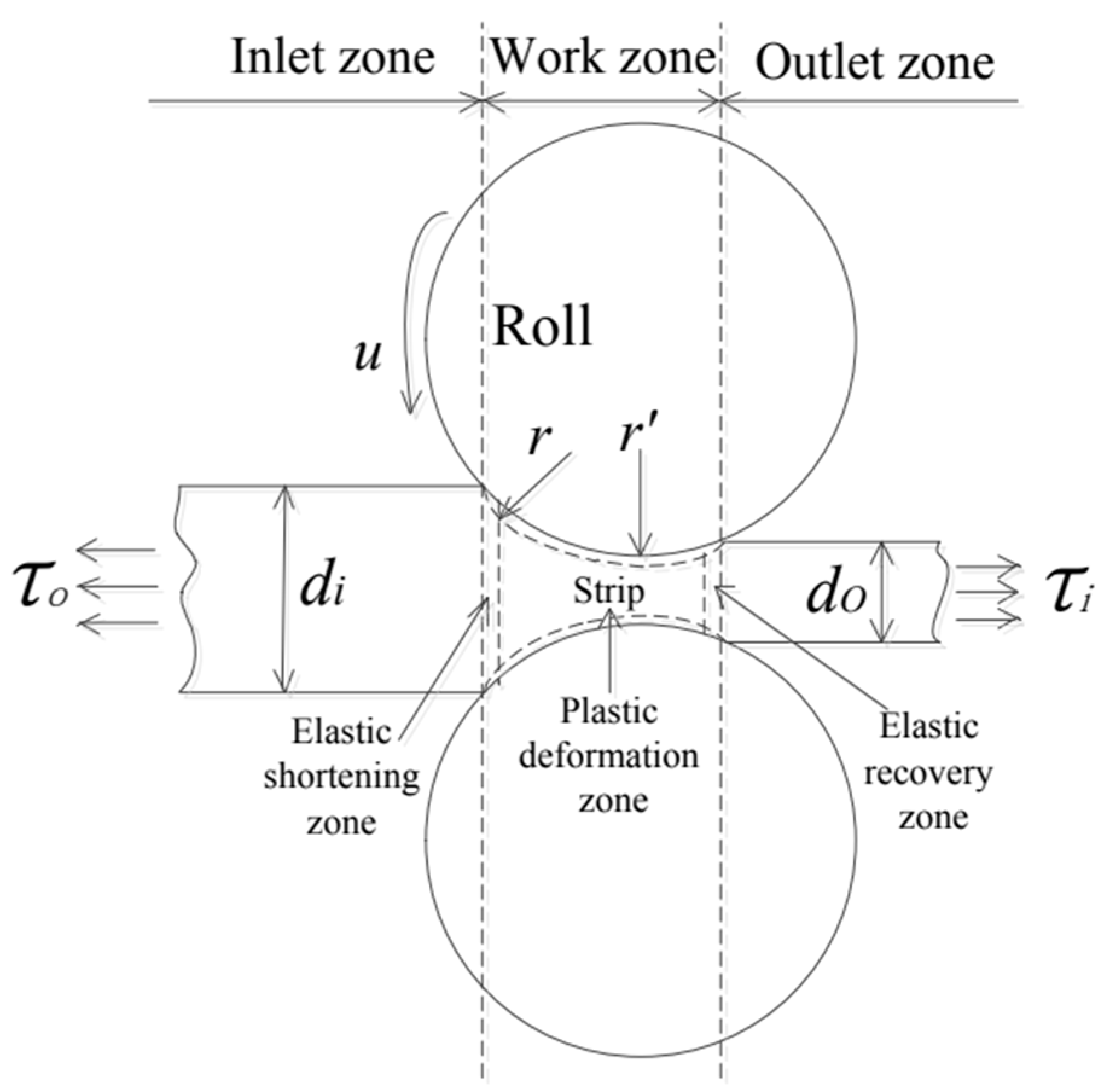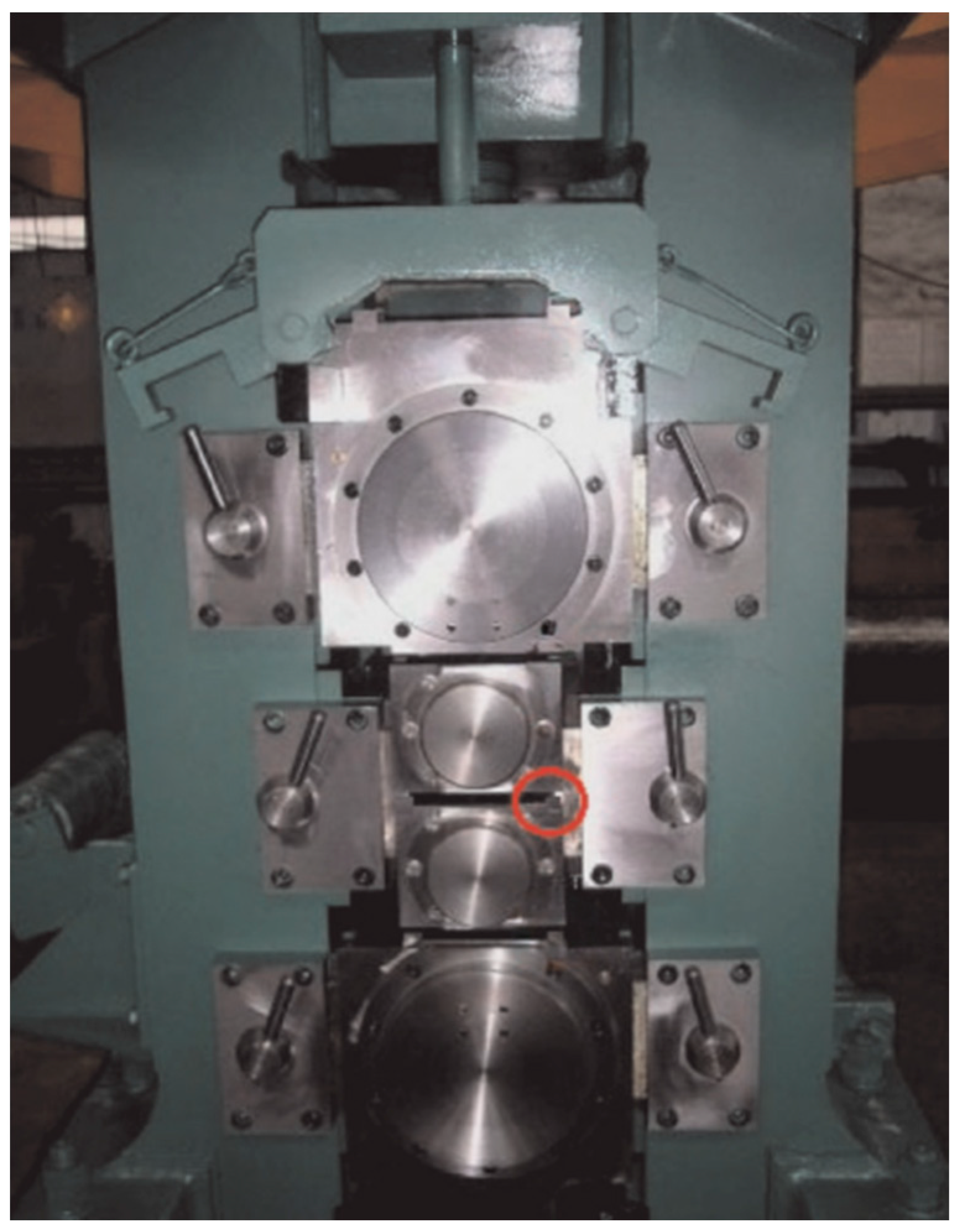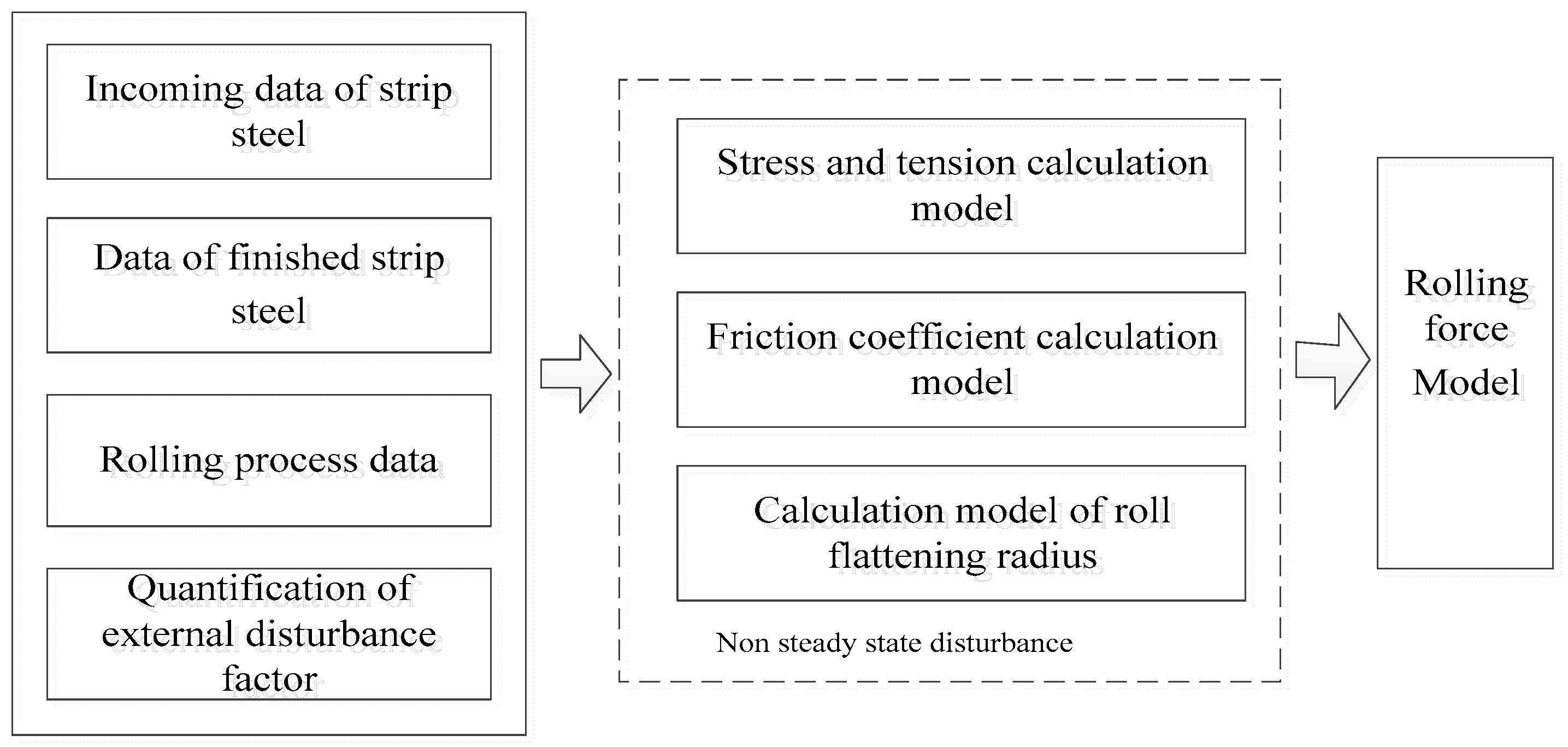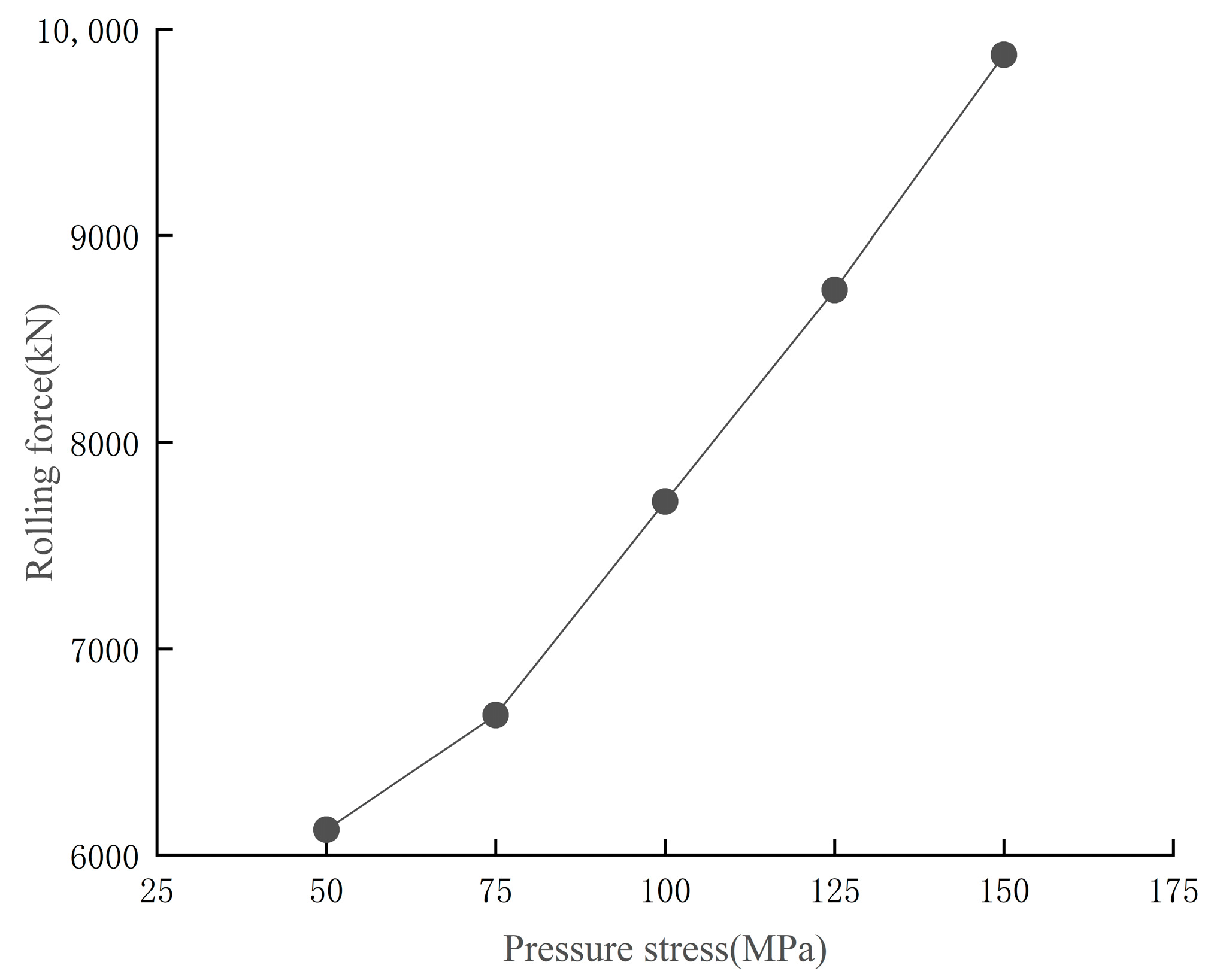Establishment and Numerical Analysis of Rolling Force Model Based on Dynamic Roll Gap
Abstract
1. Introduction
2. Theoretical Analysis of the Rolling Force Modeling
3. Consider the Dynamic Roll Gap Cold Rolling Process Model
3.1. Analysis of Cold Rolling Working Interface
3.2. Rolling Force Model
3.3. Decoupling of Roll-Flattening Radius and Rolling Force Model
4. Numerical Analysis of the Rolling Force Model
5. Conclusions
Author Contributions
Funding
Institutional Review Board Statement
Informed Consent Statement
Data Availability Statement
Acknowledgments
Conflicts of Interest
References
- Liu, Y.M.; Wang, Z.H.; Wang, T. Prediction and Analysis of the Force and Shape Parameters in Variable Gauge Rolling. Chin. J. Mech. Eng. 2022, 35, 88. [Google Scholar] [CrossRef]
- Wei, L.X.; Zhai, B.H.; Sun, H. An ensemble JITL method based on multi-weighted similarity measures for cold rolling force prediction. ISA Trans. 2022, 126, 326–337. [Google Scholar] [CrossRef] [PubMed]
- Liu, S.; Lu, H.F.; Zhao, D.X. Dynamic rolling force modeling of cold rolling strip based on mixed lubrication friction. Int. J. Adv. Manuf. Technol. 2020, 108, 369–380. [Google Scholar] [CrossRef]
- Wang, Q.Y.; Zhang, Z.; Chen, H.Q. Characteristics of unsteady lubrication film in metal-forming process with dynamic roll gap. J. Cent. South Univ. 2014, 21, 3787–3792. [Google Scholar] [CrossRef]
- Cao, L.; Li, X.; Wang, Q.L. Vibration analysis and numerical simulation of rolling interface during cold rolling with unsteady lubrication. Tribol. Int. 2021, 153, 106604. [Google Scholar] [CrossRef]
- Wu, C.; Zhang, L.; Li, S. A novel multi-scale statistical characterization of interface pressure and friction in metal strip rolling. Int. J. Mech. Sci. 2014, 89, 391–402. [Google Scholar] [CrossRef]
- Kosasih, P.B.; Tieu, A.K. Mixed film lubrication of strip rolling using O/W emulsions. Tribol. Int. 2007, 40, 709–716. [Google Scholar] [CrossRef]
- Maksimov, E.A. Reducing pressure on the rolls and tension in the asymmetric cold-rolling of strip. Metallurgist 2010, 54, 11–12. [Google Scholar] [CrossRef]
- Zhao, Q.L.; Liu, X.H.; Sun, X.K. Analysis of Mechanical Parameters of Asymmetrical Rolling Dealing with Three Region Percentages in Deformation Zones. Materials 2022, 15, 12–19. [Google Scholar] [CrossRef]
- Liu, X.H.; Xu, S.; Li, S.Q. FEM Analysis of Rolling Pressure Along Strip Width in Cold Rolling Process. J. Iron Steel Res. Int. 2007, 14, 22–26. [Google Scholar] [CrossRef]
- Zhu, G.M.; Du, F.S.; Sun, D.Y. FEM Revise of Hitchcock Equation of Calculating Working Roll′s Contact Flattening in Cold Strip Steel Rolling. Chin. J. Mech. Eng. 2003, 39, 135–137. [Google Scholar] [CrossRef]
- Sun, D.Y.; Du, F.S.; Zhu, G.M. Accurate and Fast Simulation of Rolling Force Model in Cold Strip Rolling. Iron Steel 2003, 38, 32–35. [Google Scholar]
- Le, H.R.; Sutcliffe, M.P.F. A Robust Model for Rolling of Thin Strip and Foil. Int. J. Mech. Sci. 1995, 53, 846–856. [Google Scholar] [CrossRef]
- Gao, Z.Q.; Fu, W.P.; Wang, W.; Wang, S.Q. The Modeling for the Normal Contact Stiffness and Damping of Anisotropic Interface. Mech. Solids 2021, 56, 534–550. [Google Scholar] [CrossRef]
- Yuen, W.Y.D.; Dixon, A.; Nguyen, D.N. The Modelling of the Mechanics of Deformation in Flat Rolling. J. Mater. Process. Technol. 1996, 60, 87–94. [Google Scholar] [CrossRef]
- Li, L.J.; Xie, H.B.; Liu, T.W. Effects of Rolling Force on Strip Shape during Tandem Cold Rolling Using a Novel Multistand Finite Element Model. Steel Res. Int. 2022, 93, 2100359. [Google Scholar] [CrossRef]
- Li, L.J.; Xie, H.B.; Pan, D. Influence of intermediate roll shifting on strip shape in a CVC-6 tandem cold mill based on a 3D multi-stand FE model. Int. J. Adv. Manuf. Technol. 2022, 121, 4367–4385. [Google Scholar] [CrossRef]
- Stratmann, A.; Jacobs, G.; Hsu, C.J. Antiwear tribofilm growth in rolling bearings under boundary lubrication conditions. Tribol. Int. 2017, 113, 43–49. [Google Scholar] [CrossRef]
- Heidari, A.; Forouzan, M.R.; Akbarzadeh, S. Development of a Rolling Chatter Model Considering Unsteady Lubrication. Trans. Iron Steel Inst. Jpn. 2014, 54, 165–170. [Google Scholar] [CrossRef]
- Lorentz, B.; Albers, A. A numerical model for mixed lubrication taking into account surface topography, tangential adhesion effects and plastic deformations. Tribol. Int. 2013, 59, 259–266. [Google Scholar] [CrossRef]
- Zhang, S.H.; Deng, L.; Che, L.Z. An integrated model of rolling force for extra-thick plate by combining theoretical model and neural network model. J. Manuf. Process. 2022, 75, 100–109. [Google Scholar] [CrossRef]
- Wang, Q.Y.; Cui, M.C.; Wang, H. Establishment and simulation analysis of coupled vibration system model between stands of tandem rolling mills based on rollers multi-modal mode. J. Cent. South Univ. 2020, 51, 2834–2843. [Google Scholar] [CrossRef]








| Coil Number BNZN | Steel Grade ST.MK | Striped Steel B (mm) | Incoming Material Width h (mm) | Finished Product Width H (mm) | Diameter of Work Roll r (mm) | Average Deformation Resistance (N/mm2) |
|---|---|---|---|---|---|---|
| 02049100 | AP1057 | 1262 | 2.775 | 0.870 | 307.5 | 463 |
| Rolling Pass NO | Inlet Thickness hi (mm) | Outlet Thickness ho (mm) | Post Tension τo (MPa) | Front Tension τi (MPa) | Relative Amount of Depression ε% | Speed u (m/s) | Friction Coefficient µ |
|---|---|---|---|---|---|---|---|
| 1 | 2.775 | 2.198 | 110 | 46 | 20.8 | 9.5 | 0.05 |
| 2 | 2.198 | 1.790 | 140 | 110 | 18.6 | 12.3 | 0.05 |
| 3 | 1.790 | 1.382 | 150 | 140 | 22.8 | 16.1 | 0.05 |
| 4 | 1.382 | 1.056 | 180 | 150 | 23.6 | 20.4 | 0.04 |
| 5 | 1.056 | 0.870 | 31 | 180 | 17.6 | 20.9 | 0.16 |
| Uncertainty of the Measurement | Evaluation Results (kN) | Contribute n% | Combined Uncertainty (kN) |
|---|---|---|---|
| Instrument resolution | 0.0001 | 40 | |
| Ambient condition | 0.0003 | 30 | 0.00018 |
| Measuring method | 0.0002 | 20 | |
| Other factors | 0.0001 | 10 |
| Rolling Pass NO | Measured Rolling Force (kN) | New Rolling Force (kN) | Original Rolling Force (kN) |
|---|---|---|---|
| 1 | 9370 ± 0.00018 | 8976.25 | 8019.84 |
| 2 | 10320 ± 0.00018 | 9643.87 | 9024.54 |
| 3 | 9900 ± 0.00018 | 9708.86 | 9492.02 |
| 4 | 8980 ± 0.00018 | 8876.64 | 8388.03 |
| 5 | 9500 ± 0.00018 | 8304.13 | 8110.65 |
Disclaimer/Publisher’s Note: The statements, opinions and data contained in all publications are solely those of the individual author(s) and contributor(s) and not of MDPI and/or the editor(s). MDPI and/or the editor(s) disclaim responsibility for any injury to people or property resulting from any ideas, methods, instructions or products referred to in the content. |
© 2023 by the authors. Licensee MDPI, Basel, Switzerland. This article is an open access article distributed under the terms and conditions of the Creative Commons Attribution (CC BY) license (https://creativecommons.org/licenses/by/4.0/).
Share and Cite
Tao, L.; Wang, Q.; Wu, H. Establishment and Numerical Analysis of Rolling Force Model Based on Dynamic Roll Gap. Appl. Sci. 2023, 13, 7394. https://doi.org/10.3390/app13137394
Tao L, Wang Q, Wu H. Establishment and Numerical Analysis of Rolling Force Model Based on Dynamic Roll Gap. Applied Sciences. 2023; 13(13):7394. https://doi.org/10.3390/app13137394
Chicago/Turabian StyleTao, Laihua, Qiaoyi Wang, and Huajie Wu. 2023. "Establishment and Numerical Analysis of Rolling Force Model Based on Dynamic Roll Gap" Applied Sciences 13, no. 13: 7394. https://doi.org/10.3390/app13137394
APA StyleTao, L., Wang, Q., & Wu, H. (2023). Establishment and Numerical Analysis of Rolling Force Model Based on Dynamic Roll Gap. Applied Sciences, 13(13), 7394. https://doi.org/10.3390/app13137394









